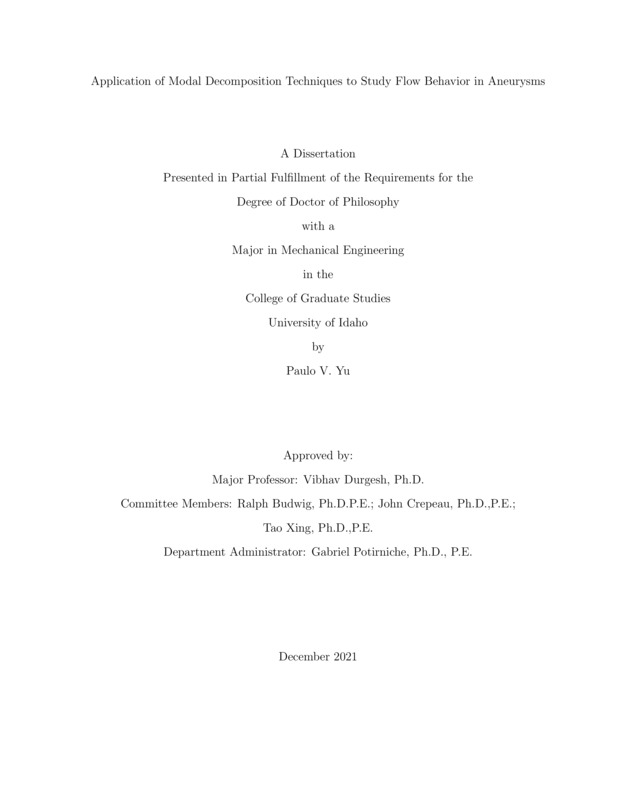Application of Modal Decomposition Techniques to Study Flow Behavior in Aneurysms
Yu, Paulo. (2021-12). Application of Modal Decomposition Techniques to Study Flow Behavior in Aneurysms. Theses and Dissertations Collection, University of Idaho Library Digital Collections. https://www.lib.uidaho.edu/digital/etd/items/yu_idaho_0089e_12286.html
- Title:
- Application of Modal Decomposition Techniques to Study Flow Behavior in Aneurysms
- Author:
- Yu, Paulo
- Date:
- 2021-12
- Keywords:
- Advanced Data Analysis DMD Experimental Fluids Fluid Dynamics PIV POD
- Program:
- Mechanical Engineering
- Subject Category:
- Engineering
- Abstract:
-
Aneurysms are localized expansions of weakened blood vessels that can be debilitating or fatal in some cases upon rupture. Previous studies have shown that aneurysm formation, growth, and rupture are complex processes influenced by factors from different disciplines like biology, material science, and fluid dynamics. Fluid mechanics is one of these factors that is important in better understanding aneurysm behavior and may lead to design of better treatment methods. However, analyzing flows in aneurysms can be challenging as the flows exhibit complex spatial and temporal behavior. For this investigation, there are two overarching goals: 1) to quantify the spatial and temporal behavior of the large-scale flow structures in aneurysms for a range of inflow conditions and two different aneurysm models, and 2) to quantify the observed flow features using modal decomposition techniques. For this study, two different, idealized, rigid, sidewall aneurysm models were used, one with a low risk of rupture and another with a high risk of rupture. An in-house experimental setup was developed using a ViVitro Labs pump system where non-dimensional inflow conditions such as Womersley number ($\alpha$) and Reynolds number ($Re$) were varied to match conditions typically found in the human circulatory system. An aqueous glycerin solution was used to match the index of refraction of the models. Particle Image Velocimetry (PIV) was used to measure the flow field in the aneurysm models. The hardware synchronization-based alias imaging approach was used to capture the behavior of large-scale flow structures at different phases in the flow cycle. Advanced analysis methods such as Proper Orthogonal Decomposition (POD) and Dynamic Mode Decomposition (DMD) were utilized to identify the spatial and temporal behavior of the large-scale flow structures in the aneurysm.
This investigation showed that large-scale flow structures in the aneurysm are influenced by changes in $Re_{p}$, $\alpha$, and morphology. The complex behavior of large-scale flow structures, in turn, influences the path and strength of these vortical structures, their growth and decay, and the impinging location and wall shear stress distribution. These variations in high-shear stress zones and impinging locations can be correlated to high and low risk of rupture in the studied aneurysm models. POD provided an optimal modal description of the observed large-scale flow structures. POD analysis showed the interplay of modes and highlighted how the large-scale structure evolves during the different phases of flow and impacts fluid dynamics parameters. Furthermore, the mathematical description of the flow fields defined by POD modes also provided a method to qualitatively compare the observed flow features in aneurysm studies. In contrast, the DMD modes are not optimal, but they provided critical information about the dynamics of flows and the spatial-temporal behavior of the flow structures. DMD provided frequencies and growth rates of the spatial structures. DMD analysis clearly demonstrated that the large-scale flow features and dynamics are influenced by the $Re_{p}$, $\alpha$, and aneurysm shapes. We also developed a framework for using DMD with traditional velocity field measurements and a low-frame rate setting for this investigation. This framework allowed us to observe high-frequency flow features despite using low-frame rate PIV systems. Finally, this study also showed that both POD and DMD provide flow information at any desired phase in the flow cycle, saving considerable experimental time compared to phase-locked measurements.
- Description:
- doctoral, Ph.D., Mechanical Engineering -- University of Idaho - College of Graduate Studies, 2021-12
- Major Professor:
- Durgesh, Vibhav
- Committee:
- Crepeau, John; Budwig, Ralph; Xing, Tao; Potirniche, Gabriel
- Defense Date:
- 2021-12
- Identifier:
- Yu_idaho_0089E_12286
- Type:
- Text
- Format Original:
- Format:
- application/pdf
- Rights:
- In Copyright - Educational Use Permitted. For more information, please contact University of Idaho Library Special Collections and Archives Department at libspec@uidaho.edu.
- Standardized Rights:
- http://rightsstatements.org/vocab/InC-EDU/1.0/

